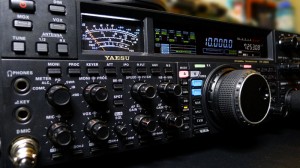 In this article I will describe how to install a dipole antenna fifty feet up into the trees without any help. Why? Because self-sufficency is a good thing, especially if you’re lonely.
In this article I will describe how to install a dipole antenna fifty feet up into the trees without any help. Why? Because self-sufficency is a good thing, especially if you’re lonely.
First, let me set the stage. The first thing you need to know is that I am an idiot. Now, I’m not your typical idiot who is blessed with something as simple as a low IQ. No, I am a special type of idiot: one in which my measured intelligence is in the top two percent of those measured, but whose propensity towards doing stupid things nears infinity.
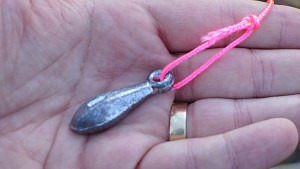 Take, for example, my calculated attempt at launching a weighted object fifty feet into the air in order to cast an attached line over a tree limb. Countless people on-line recommended this method and yet I never stopped to realize that launching a three ounce fishing weight straight up would result in said fishing weight coming straight back down towards my unguarded head. Gravity, I have since learned, is a bitch.
Take, for example, my calculated attempt at launching a weighted object fifty feet into the air in order to cast an attached line over a tree limb. Countless people on-line recommended this method and yet I never stopped to realize that launching a three ounce fishing weight straight up would result in said fishing weight coming straight back down towards my unguarded head. Gravity, I have since learned, is a bitch.
It was this event, of which my daughter bore witness, that caused me to forever abandon the idea of hurling lead weights into the air. Instead, I reasoned that something softer, rounder, and perhaps even fuzzier would do. I then had the epiphany that tennis balls are a ham’s perfect projectile. The perfect weapon for launching these projectiles? The simple fishing pole.
 Tennis balls apparently aren’t designed to be attached to, well, anything, so I needed to
Tennis balls apparently aren’t designed to be attached to, well, anything, so I needed to destroy alter one in order to get it attached to the fishing line. As a man, I couldn’t help but reach for the power tools. I reasoned that by drilling two holes in a ball, I could then tie said ball directly to the fishing line and call it a day. Naturally, that plan failed. As any fisherman will tell you, tying a lure directly to the line makes it hard to change lures, which is why lure-weilding fishermen use leaders. Remembering this as my first experiments failed, I added fishing leaders to my shopping list.
You may have noticed that my tennis balls have fun little doggie paws emblazoned on them. Since I was mangling improving my tennis balls in such a way that would render them useless for pointless activities such as tennis, I purchased a three-pack of dog toys that resembled tennis balls in principle only. I figured since my goal was to hurl these perforated balls into the trees, I didn’t need to spend big money on the good stuff. Spending 99 cents on a three-pack made good financial sense since I had spent way too much money on all the other nonsense involved.
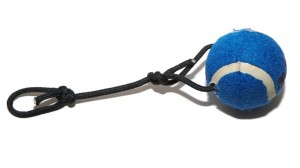 With the holes drilled, I folded some of my antenna rope over the tip of a flat blade screwdriver and jammed it through both holes. In case you’re wondering, antenna rope is indeed one of the items included in the pricey other nonsense category mentioned previously. Having a tethered ball, I then cut the rope, and tied a knot on the other end. I used bowline knots, ostensibly because they tighten under load, but realistically because it’s one of the few knots I will never forget how to tie (thanks dad). I could have just tied a single loop of rope, but then I wouldn’t have needed to take pictures in order to show off my bowline-tying skills which are, as the kids say, epic.
With the holes drilled, I folded some of my antenna rope over the tip of a flat blade screwdriver and jammed it through both holes. In case you’re wondering, antenna rope is indeed one of the items included in the pricey other nonsense category mentioned previously. Having a tethered ball, I then cut the rope, and tied a knot on the other end. I used bowline knots, ostensibly because they tighten under load, but realistically because it’s one of the few knots I will never forget how to tie (thanks dad). I could have just tied a single loop of rope, but then I wouldn’t have needed to take pictures in order to show off my bowline-tying skills which are, as the kids say, epic.
If you try this at home, one of the first things you will likely learn is that typical hobby fishing line is not strong enough. On my third practice cast, my four-pound test line snapped, hurling my nice bowline-knoted tether-ball creation over the tree-line and into the woods where it was lost forever. I made a mental note to buy more pet-branded novelty tennis balls when I went out to buy heavier fishing line.
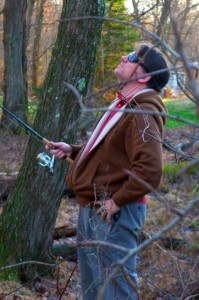 With a pile of new imitation tennis balls and some 10-pound test line, I sat down to convert the balls to antenna-launching grenades. Once that was done, I set about the task of removing the lightweight fishing line from my spinning reel and replacing it with the heavy duty stuff. I got to wield my knot-tying prowess once more as I
With a pile of new imitation tennis balls and some 10-pound test line, I sat down to convert the balls to antenna-launching grenades. Once that was done, I set about the task of removing the lightweight fishing line from my spinning reel and replacing it with the heavy duty stuff. I got to wield my knot-tying prowess once more as I tied looked up how to tie the arbor knot necessary to secure the line to the reel. My equipment prepared, I gathered my antenna rigging accouterments and set out into the woods.
On the first excursion into the forest, Colleen came along to help. Her job was to document the proceedings, which, according to the official record, involved two hours of me staring into the sky with a fishing pole in my hand. On this, my second trip, I decided to go alone, though to be honest, that’s because I was home alone all day and not because Colleen begged me to leave her out of any future “antenna-rigging nonsense”.
Dipole antennas like to be high, and there are countless webpages that provide measurements and recommended heights. Alas, I was limited by the trees and branches available to me so I picked three trees that coincided with the feed-point and two ends, and worked from there. My first target chosen, I aimed my fishing pole, and cast my rope-bound fuzzy grenade to the sky. To my absolute dumbfounded shock, my first cast sent the ball sailing up into the air, arcing perfectly over my branch of choice. I considered adding “antenna rigging” to my resume right below “bowline knot-tying master” in the miscellaneous skills section. Smug with my success, I pressed on.
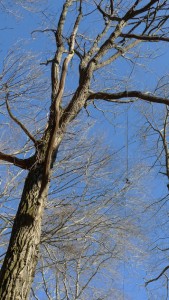 As I let the line unwind, the weight of the ball pulled it down to earth. I unclipped the ball from the leader, and using another bowline knot (you can never have too many), tied on the open end of my spool of antenna rope. As I reeled in the line, the spool of rope unfurled up into the tree according to plan. This was working perfectly!
As I let the line unwind, the weight of the ball pulled it down to earth. I unclipped the ball from the leader, and using another bowline knot (you can never have too many), tied on the open end of my spool of antenna rope. As I reeled in the line, the spool of rope unfurled up into the tree according to plan. This was working perfectly!
When the rope got to the branch, it hit a snag of particular malice after which no amount of fiddling would release the line. Even the weight of fifty feet of hanging rope combined with all the arm-waving and gesticulation I could muster would not free my creation from the tree. After twenty minutes of stubborn battle with the rope, considerable swearing, and promises that I would get my chainsaw if the tree didn’t let go, I conceded defeat and cut the line. It took me twelve casts and two more tennis balls to get the rope back where I wanted it. As I cast again and again, I contemplated how this dance of failure after a hint of success could be used as a metaphor for my entire life.
With the line finally over the limb again, I started to build my designed system of ropes. For each of the three support points, I planned on two sets of rope. First, I would use the line over the limb as a halyard line. On this line, I would hang a pulley from which I would hang the second line. This second line would be the line supporting the antenna. It sounds complicated, but don’t worry, bowline knots make it simple.
My reasons for this design were two fold. First, should the line remain in the tree long enough for the tree to grow around it, I could still raise and lower the antenna through the attached pulley. Second, I could always cut the loop and recover the pulley. Since the pulleys I used were delrin-based marine pulleys, they cost about forty dollars each, so the ability to recover them seemed like a good idea.
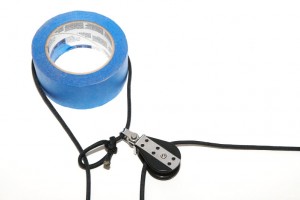 It wasn’t until I photographed my brilliance for this article after the antenna was hung that I realized the error in my carefully thought-out plan. With a bowline knot on one end of the line over the branch (simulated by a roll of blue painter’s tape here), I threaded the other end of the line through the loop. Before I tied the bowline, I threaded the pulley onto the rope. With the antenna line through the pulley, I hauled the halyard, thus raising the pulley into the sky. Brilliant! The problem is that if the halyard grows into the tree and I cleverly cut it, the pully will still be stuck in the tree because it is held up by the expertly tied bowline knot. Yet one more example of how I am the dumbest smart person my wife has ever met. At some point I’ll have to go out and re-rig all three trees putting the pully on the other leg of the halyard, but for now, I really just don’t have the energy.
It wasn’t until I photographed my brilliance for this article after the antenna was hung that I realized the error in my carefully thought-out plan. With a bowline knot on one end of the line over the branch (simulated by a roll of blue painter’s tape here), I threaded the other end of the line through the loop. Before I tied the bowline, I threaded the pulley onto the rope. With the antenna line through the pulley, I hauled the halyard, thus raising the pulley into the sky. Brilliant! The problem is that if the halyard grows into the tree and I cleverly cut it, the pully will still be stuck in the tree because it is held up by the expertly tied bowline knot. Yet one more example of how I am the dumbest smart person my wife has ever met. At some point I’ll have to go out and re-rig all three trees putting the pully on the other leg of the halyard, but for now, I really just don’t have the energy.
I screwed an eye bolt into each of the trees so that I’d have something to tie off all these lines. I know a lot of people don’t like to hurt the trees, and I can appreciate that. I grew up on a farm, and we used trees for everything from a platform for tires swings to a place to nail in an electric fence. I made sure to thank each tree for its service, but I stopped short of giving them each a hug. Besides, the trees should feel lucky that I didn’t cut them all down in a fit of rage after they refused to release my snagged first line.
With each of the three trees rigged, I mounted the antenna and hauled it up into the trees. With hours of rigging and knot tying, pulling the antenna up took all of five minutes which is exactly the kind of time-savings I enjoy. The pulleys give me the flexibility of adding counter-balances to the antenna, but I have a feeling that between the exiting pulley system and the slight slack in the antenna, that even a strong wind won’t break it. Time will tell.
[dropshadowbox align=”center” effect=”raised” width=”90%” height=”” background_color=”#ffffff” border_width=”1″ border_color=”#dddddd” ]I originally wrote this piece in 2011. In 2012, Hurricane Sandy slammed into the East Coast and wreaked havoc with its powerful winds. We had no power for two weeks after which I went to check on my antenna. The ropes had held, as had the pulleys, but the wind-swept trees had managed to pull the insulator right off of one end of the dipole. Such is the magnificent power of the bowline knot.[/dropshadowbox]With the antenna where it needed to be, I set out to run the coax feed line. Since the antenna is in the woods and is strictly for HF bands, I chose RG-213 coax for its combination of low loss and flexibility. This part was pretty boring though, because I couldn’t tie any bowline knots in the thick cable.
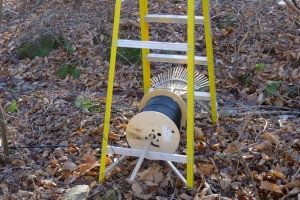 Running the cable was actually pretty simple. I put the 500-foot spool of coax on the handle of a rake, and rested the handle on the bottom rungs of a folding ladder. With this setup I was able to easily pull 250 feet of it out while walking through the woods by my lonely self.
Running the cable was actually pretty simple. I put the 500-foot spool of coax on the handle of a rake, and rested the handle on the bottom rungs of a folding ladder. With this setup I was able to easily pull 250 feet of it out while walking through the woods by my lonely self.
At each end of the run I soldered on a silver-plated PL-239 using my handy butane torch, made the connections as waterproof as possible, and the job was done. I then threw the cable through an open window and was on the air. If you’re wondering about permanent entry points, lightning suppression, grounding, and those sorts of things, stay tuned because there are all ready too many words in this article so those topics will get their own.
In summary, this is not the type of installation you’d see on the cover of CQ magazine but for my uses it’s just perfect. Sure, I’d love to have a 300-foot tower with multiple antennas hooked up to my 2000-watt linear, but you know what? I don’t have any of that stuff, and my simple dipole does the job just fine at the modest 100 watts my radio can deliver. Besides, I don’t like ladders and my dipole was (sort of) easy to install by myself and now that it’s up I don’t have to be lonely any more!
[dropshadowbox align=”center” effect=”raised” width=”90%” height=”” background_color=”#ffffff” border_width=”1″ border_color=”#dddddd” ]My wife just came in to tell me that I should stop saying that I’m lonely because something something about people loving you or something. I don’t know. Sounded important, though. [/dropshadowbox]Ooh – the 40-meter band just opened up. Gotta go!
Donate: PayPal Crypto:
ETH: 0x0AC57f8e0A49dc06Ed4f7926d169342ec4FCd461
Doge: DFWpLqMr6QF67t4wRzvTtNd8UDwjGTQBGs
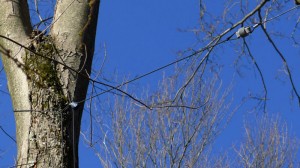
Hi Gary,
I’m planning on rigging a wire antenna this weekend and have being trawling the web for anything I could find that would give me a small advantage over myself as rarely do these projects go as I plan them.
I noticed from reading you blog that you’d threaded the antenna wire through the pulley and was wondering how this has stood up over two winters?
Very much enjoyed reading your article,
Kind regards and 73,
psi clarke
Hi Gary,
Your article covers exactly what I will be doing here in the woods of north Texas. I dusted off my SX-99 from my ham radio days in the ’50s so I can do some SWL. Strung some coax and speaker wire out thru the woods and verified the receiver works so now it is time to install a long wire of high quality. My favorite hobby is RC model planes and quad copters so perhaps the quad will be used to string the cord in the trees – what could go wrong with that!
Thanks for your detailed account which is most instructive. Now I need to learn to tie the bowline knot.
73, Terry
In California’s central valley, trees are our friends. However, I don’t hug ’em either. They do provide shade for the hot summer months, but then loaf about not doing a darn thing after shedding their skin ALL OVER the yard in the fall and winter. I found your informative and entertaining page looking for ideas on hanging wire antenna ends in trees. I like what you’ve done. I’m thinking I’ll take my chainsaw out and just set it on a table while securing ropes to the trees – not so much for cutting… no, more like a threat of what could happen if the trees don’t cooperate. Trees can be wily and mischievous if left to themselves.
Thanks much for a great story told with such a charming tone. Fred N4CYF
I thought about how you mounted the pulley and feeding the rope through the bowline could cause it to cinch up on the branch. With luck, and not pulling the rope taught, you should be able to pull it down with the rope at the end of the antenna. My thought was to tie the pulley to the end of the rope–less likely for the rope to get buried in the tree.
Thanks for the great story. I learned of it while searching other ways to get antenna wire into trees. Thanks for the idea of the tennis ball and fishing pole. It worked great. I’m in the same situation as you with my property and how to get the wire up in the trees without harming myself or anyone else. I did try the old slingshot and lead sinker without any luck.
Yeah, it takes a few casts to get a line “where” you WANT it!! But it’s easier if you: Use a one ounce sinker, paint the sinker a fluorescent color (or bright duct tape), use a sinker that has a steel lug to attach a fishing swivel on it, don’t latch the swivel closed so you can pull it open with your rod if it gets stuck, use the swivel after you fetch the sinker and use it to pull your guy line (trimmer line or 1/16″ steel braid) back over the appropriate limb. Don’t be afraid to pull your sinker back to the thickest branch and re-drop it back to the ground in the most straight down fashion. I’ve gotten a one ounce sinker up about 70ft with accuracy + or – 5 feet right and left – so it will take a few throws to get where you want. Multiple tries means locating the sinker on the ground and releasing it from the swivel – re-snap the swivel to keep it snag free when you retrieve the line back to your saltwater rod/reel for another try. Patience and planning.
Thanks for the article. I have some fishing line about 20 meters into a tree right now. I was trying to figure out my next steps to properly place the antenna. Your approach looks fine to me.
Hi Gary–Your prose is very entertaining while informative. Kinda makes ol’ Garrison Keillor look like a wannabe. Keep up the good work & 73!
KG0O
Thanks!
Nice work, Gary. Your pros and technique are still saving the day …likely the lives of a tree or two, too… before my project is complete in the next few days. Your Keillor’esque recounting of the stressors of real life situations is commendable. In tune with some of your other passions there’s likely trouble in the forest somewhere in this Hemisphere[s] anyway so I too will bring a chainsaw as I Rush out into my Southern Indiana woods. Thanks for the motivational tale. Geddy up!
I will be reading more into your well-annotated history as I build out the rest of my first shack in this tiny box near the woods.
73,
– Joe / KC9NVY
What a delightfully poetic comment. Good luck with the shack!